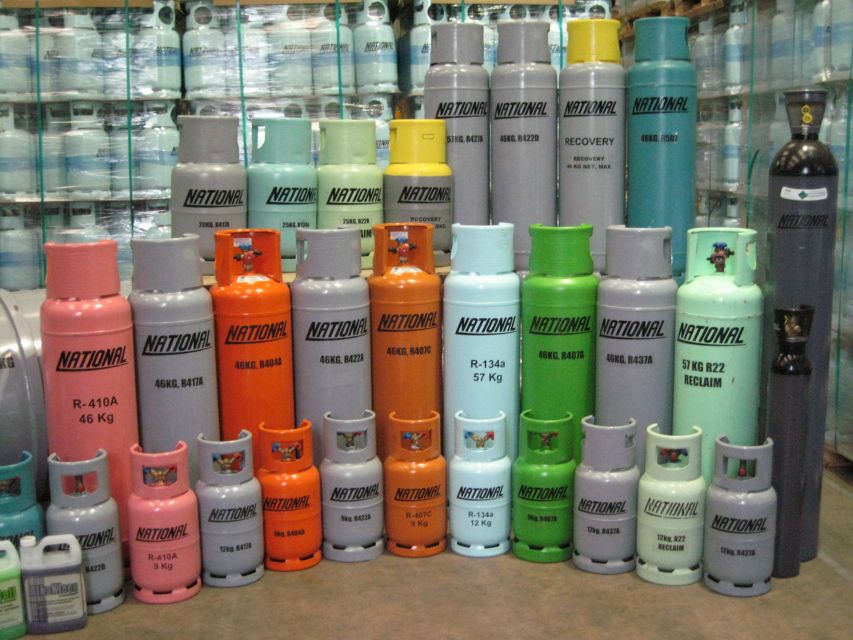
Just like an air-conditioning unit uses refrigerant to cool the air, medical chillers use refrigerant to cool fluid used in medical equipment processing. If you’re looking for medical chillers for your imaging or medical facility, this article will outline the different types of gas refrigerants available to keep your lifesaving equipment running strong. First, we’ll start with a definition of medical chillers and outline a few of their primary field applications.
What are medical chillers?
Medical chillers are specialized industrial process chillers that use air, water, or a split configuration to keep medical equipment processes cool. With year-round cooling capability, temperature accuracy, reliability, and energy efficiency, medical chillers are designed specifically for optimal performance and uptime.
Medical chillers are used for many types of imaging and other equipment, including:
- MRI machines
- CT scanners
- Linear accelerators (LINAC)
- Laboratory reagents
- Pharmaceutical equipment
Learn more about the types of medical chillers available to equip your imaging or other medical equipment on our website.
Next, let’s look at the types of gas refrigerants medical chillers use.
7 Types of gas refrigerants used in medical chillers
1. R134A
R134A is a widely used hydrofluorocarbon (HFC) and haloalkane refrigerant, also known as norflurane or freon 134A.
- HFC refrigerant with stable thermal characteristics and low toxicity
- Non-corrosive and non-combustible
- Low global warming potential (GWP)
2. R513A
R513A is a hydro-fluoro-olefin (HFO) refrigerant for medical chillers in imaging or medical environments that require medium refrigerant temperatures.
- HFO blend containing hydrogen, fluorine, and carbon
- For medium temperature refrigerant requirements
- Low global warming potential (GWP)
3. R407C
R407C is a hydrofluorocarbon (HFC) blend with properties designed for optimal medical chiller performance.
- HFC blend comprised of hydrogen, fluorine, and carbon
- For low to medium temperature refrigerant requirements
- Replacement for R22 and R404A
4. R404A
R404A is a hydrofluorocarbon (HFC) refrigerant blend that offers excellent process cooling for medical chillers in environments where low to medium temperature refrigerant is required.
- HFC blend of hydrogen, fluorine, and carbon
- For low to medium temperature refrigerant requirements
- EPA to phase out the use of this refrigerant
5. R507
R507 is another gas refrigerant for medical chillers comprised of a hydrofluorocarbon (HFC) blend for low and medium refrigerant temperature requirements.
- HFC blend comprised of hydrogen, fluorine, and carbon
- For low to medium temperature refrigerant requirements
- Replacement for R502
6. R448A
R448A is a non-flammable hydro-fluoro-olefin (HFO) blend for high-performance medical chillers. While it contains toxic properties and requires careful handling, installation, and storage, it has low global warming potential (GWP).
- HFO blend containing hydrogen, fluorine, and carbon
- Requires careful handling, installation, and storage
- Low GWP
7. R449A
R449A is another hydro-fluoro-olefin (HFO) blend for medical chillers for low to medium temperature applications. It is environmentally friendly with low global warming potential (GWP) and can be easily retrofitted in old chiller systems or installed in newer models.
- HFO blend of hydrogen, fluorine, and carbon
- For low to medium temperature requirements
- Low GWP
What advantages can you expect from these refrigerants? Continue reading to find out more.

Advantages of gas refrigerants for medical chillers
No matter the type of gas refrigerant used for medical chillers or other industrial process chillers, they offer many environmental and performance advantages, including:
- High efficiency
- Environmentally friendly
- Medium pressure for year-round operation (as opposed to high pressure with A/C that’s only good for 3-4 months of the year)
- Many low global warming potential (GWP) options, such as R448A, R449A, R134A, and R513
To find out more about the types of gas refrigerants used in medical chillers, contact our industrial chiller experts for advice about the best option for your medical application. We offer robust engineered solutions and many customizations to meet your specific requirements, all at an affordable price. With nearly 50 years of experience and a proven 99.4% uptime rate, we have the knowledge and expertise to help you deliver the care your patients need – when they need it. For added peace of mind, we offer short lead times and excellent after-the-sale support.

